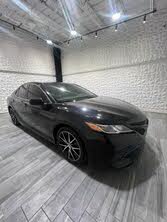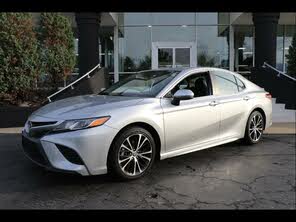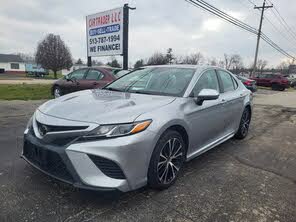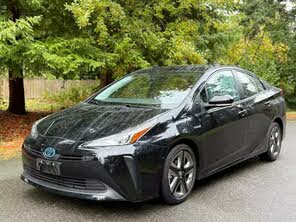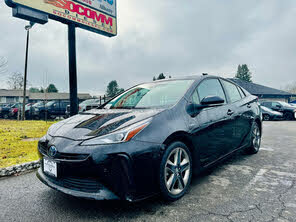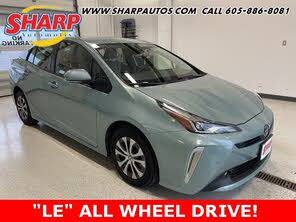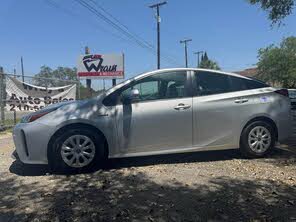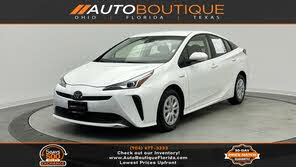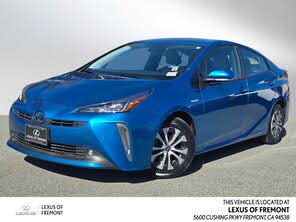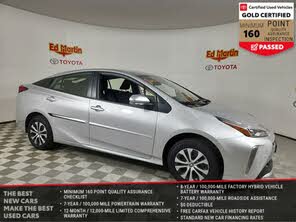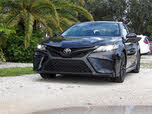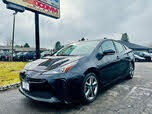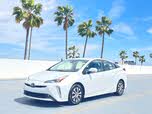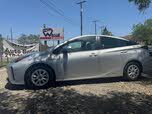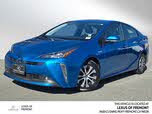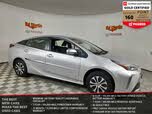2020 Toyota Camry vs 2021 Toyota Prius
Overview | |
MSRP$24,425 | MSRP$24,525 |
Average price$21,190 | Average price$21,998 |
Listings1350 | Listings224 |
Ratings & Reviews | |
User Reviews | User Reviews |
Expert reviews7.5 out of 10 | Expert reviews6.2 out of 10 |
Pros
| Pros
|
2020 Toyota Camry Reviews SummaryIf you can't beat them, join them. That seems to be Toyota's philosophy in updating the eighth generation of the Camry for the 2020 model year. This latest version of the perennial best seller debuted in 2017 as a 2018 model—and promptly lost its sales crown to Toyota's own RAV4 crossover SUV. As buyers continue to defect from cars, Toyota hopes to entice more shoppers to stick with its midsize sedan by offering all-wheel drive on the Camry for the first time since 1991. Also new for 2020 is the Camry TRD, a sportier version with a 301-horsepower V6 engine that makes its case to a buyer who might never have considered a Camry. | |
2021 Toyota Prius Reviews SummaryTo many people, cars are appliances made to serve a function. These consumers own a car because they need to get from where they are to where they’re going, and with a minimum of hassle, expense, or discomfort. Reliability, efficiency, safety, and economy are the critical deciding factors, and the 2021 Toyota Prius delivers on all fronts. Confusingly, for 2021, the Prius lineup offered a 2020 Edition. Toyota built just 2,020 examples to commemorate the 20th anniversary of the first Prius sold in the U.S. market. It has blacked-out trim, black 17-inch wheels, a body-color rear spoiler, and comes in Supersonic Red or new Wind Chill paint colors. Additionally, Toyota improved the 2021 Prius’s driving-assistance systems by making Toyota Safety Sense 2.0 standard across the board. Android Auto is also standard (joining Apple CarPlay), except for the unique infotainment system in the Prius Limited. | |
No video found | No video found |
Popular Features & Specs | |
Engine2.5L 203 hp I4 | Engine1.8L 121 hp I4 Hybrid |
Drive TrainFWD | Drive TrainFWD |
Seating Capacity5 | Seating Capacity5 |
EV Battery Capacity | EV Battery Capacity0.7 kWh |
MPG City29 | MPG City58 |
MPG Highway41 | MPG Highway53 |
Engine | |
Engine Name2.5L 203 hp I4 | Engine Name1.8L 121 hp I4 Hybrid |
DrivetrainFWD | DrivetrainFWD |
Fuel Economy | |
EV Battery Capacity | EV Battery Capacity0.7 kWh |
MPG City29 | MPG City58 |
MPG Highway41 | MPG Highway53 |
Interior | |
Seating Capacity5 | Seating Capacity5 |
Safety | |
Front Crash Overall5 | Front Crash Overall4 |
Side Crash Overall5 | Side Crash Overall5 |
Dimensions & Capacity | |
Cargo Space14.1 cu ft | Cargo Space27.4 cu ft |
Curb Weight3241 lbs | Curb Weight3010 lbs |
Height56.9 in | Height57.9 in |
Length192.1 in | Length180.0 in |
Width72.4 in | Width69.3 in |
Wheelbase111.2 in | Wheelbase106.3 in |
Maximum Payload925 lbs | Maximum Payload825 lbs |
Number of doors4 | Number of doors4 |
Overview | ||
MSRP | $24,425 | $24,525 |
Average price | $21,190 | $21,998 |
Listings | ||
Ratings & Reviews | ||
User reviews | ||
Expert reviews | 7.5 out of 10Read full review | 6.2 out of 10Read full review |
Pros & cons | Pros
| Pros
|
Summary | If you can't beat them, join them. That seems to be Toyota's philosophy in updating the eighth generation of the Camry for the 2020 model year. This latest version of the perennial best seller debuted in 2017 as a 2018 model—and promptly lost its sales crown to Toyota's own RAV4 crossover SUV. As buyers continue to defect from cars, Toyota hopes to entice more shoppers to stick with its midsize sedan by offering all-wheel drive on the Camry for the first time since 1991. Also new for 2020 is the Camry TRD, a sportier version with a 301-horsepower V6 engine that makes its case to a buyer who might never have considered a Camry. | To many people, cars are appliances made to serve a function. These consumers own a car because they need to get from where they are to where they’re going, and with a minimum of hassle, expense, or discomfort. Reliability, efficiency, safety, and economy are the critical deciding factors, and the 2021 Toyota Prius delivers on all fronts. Confusingly, for 2021, the Prius lineup offered a 2020 Edition. Toyota built just 2,020 examples to commemorate the 20th anniversary of the first Prius sold in the U.S. market. It has blacked-out trim, black 17-inch wheels, a body-color rear spoiler, and comes in Supersonic Red or new Wind Chill paint colors. Additionally, Toyota improved the 2021 Prius’s driving-assistance systems by making Toyota Safety Sense 2.0 standard across the board. Android Auto is also standard (joining Apple CarPlay), except for the unique infotainment system in the Prius Limited. |
Video | No video found | No video found |
Popular Features & Specs | ||
Engine | 2.5L 203 hp I4 | 1.8L 121 hp I4 Hybrid |
Drive Train | FWD | FWD |
Seating Capacity | 5 | 5 |
EV Battery Capacity | 0.7 kWh | |
MPG City | 29 | 58 |
MPG Highway | 41 | 53 |
Engine | ||
Engine Name | 2.5L 203 hp I4 | 1.8L 121 hp I4 Hybrid |
Drivetrain | FWD | FWD |
Fuel Economy | ||
EV Battery Capacity | 0.7 kWh | |
MPG City | 29 | 58 |
MPG Highway | 41 | 53 |
Interior | ||
Seating Capacity | 5 | 5 |
Safety | ||
Front Crash Overall | 5 | 4 |
Side Crash Overall | 5 | 5 |
Dimensions & Capacity | ||
Cargo Space | 14.1 cu ft | 27.4 cu ft |
Curb Weight | 3241 lbs | 3010 lbs |
Height | 56.9 in | 57.9 in |
Length | 192.1 in | 180.0 in |
Width | 72.4 in | 69.3 in |
Wheelbase | 111.2 in | 106.3 in |
Maximum Payload | 925 lbs | 825 lbs |
Number of doors | 4 | 4 |
The 2020 Toyota Camry experienced a significant transformation with its expressive styling and enhanced attention to detail, rejuvenating its appeal and status. Historically, the Camry earned its reputation for quality and reliability, largely due to its robust engineering shared with the Lexus brand. However, recent years saw a decline in its perceived quality, especially compared to rivals like the Honda Accord and Hyundai Sonata. The latest generation of the Camry addressed these concerns with a fresh focus on craftsmanship and design.
The exterior of the 2020 Camry showcased a bold front fascia and taut lines that exuded a sporty character unprecedented in previous models. Certain design elements drew inspiration from BMW, such as the character line running across the doors and the upturned kink of the C-pillar. The availability of 14 exterior color options, including a black roof option, aimed to make this Camry fashionable and visually appealing. The interior reflected this external boldness with uniformly high-quality materials, creating a driver-focused cabin that conveyed a sense of luxury. Specifically, the TRD model featured red trim accents and even bright red seatbelts, borrowing a touch from high-end sports car aesthetics. The top-tier trims, with their leather and wood elements, suggested parallels with entry-level Lexus vehicles, though the Camry remained distinctly Toyota.
Conversely, the 2021 Toyota Prius stayed true to its established boomerang-shaped hood and roofline, a design choice that had been integral to its identity for over 15 years. Despite advances in aerodynamics that made such extreme design elements unnecessary, the Prius retained its unique look, though not universally appreciated. The Prius 2020 Edition, even with trendy blacked-out trim, didn’t escape criticism for its unconventional style.
Inside, the Prius continued its quirky theme with a strip of displays mounted centrally near the windshield for instrumentation and a toggle lever on the dashboard for transmission controls. The interior design wrapped dramatically into the door panels, with an infotainment pod protruding towards the front seat occupants. The glossy black trim was notably prone to dust and fingerprints, detracting from the overall experience.
The 2020 Toyota Camry offered a variety of powertrains, emphasizing a balance between performance and efficiency. The 3.5-liter V6 engine, producing 301 horsepower, stood out for its smooth and powerful performance, significantly enhancing the luxurious feel of higher trims like the XLE. However, in the sportier TRD trim, this engine felt somewhat mismatched, even with a dual exhaust system intended to boost its acoustic appeal. In contrast, the 2.5-liter four-cylinder engine, delivering 203 hp (206 in XSE trim), punched above its weight, especially when paired with the eight-speed automatic transmission. The lighter front end aided by this powertrain made the Camry feel more agile, particularly in the sporty XSE trim. The AWD system, available with the 2.5-liter engine, further enhanced handling and traction without significantly compromising fuel efficiency.
The 2021 Toyota Prius focused on fuel efficiency, with the L Eco version achieving an impressive 56 mpg combined according to the EPA, and other front-drive models not far behind at 52 mpg combined. The AWD-e versions, while slightly less efficient at 49 mpg combined, still maintained commendable fuel economy. Powered by a 1.8-liter four-cylinder engine paired with a 53-kilowatt electric motor and an e-CVT, the Prius’ total system output amounted to 121 horsepower. This modest power was somewhat offset by the electric motor's near-instantaneous torque, making the Prius feel lively at lower speeds and providing electric-only driving capability at speeds under 25 mph for improved efficiency. The various driving modes—Eco, Normal, and Power—allowed drivers to prioritize efficiency or responsiveness, though the Power mode mainly added noise without substantial acceleration benefits.
Inside, the 2020 Toyota Camry maintained its reputation for ease of use, with intuitive controls and ergonomic design. Despite stylistic updates, front seat legroom and hip room increased, preserving occupant comfort. However, the rear seat experienced a reduction in legroom and overall passenger volume, along with a trunk capacity of 15.1 cubic feet, which, while not tiny, was smaller compared to competitors. Importantly, the addition of AWD did not further compromise interior space or trunk size, highlighting Toyota's thoughtful design adjustments like the modified floor structure and electronic parking brake.
On the other hand, the 2021 Toyota Prius surprised people with its relatively spacious interior for a vehicle often considered small. Able to accommodate up to five passengers, it offered comfortable seating despite Toyota’s SofTex synthetic leather being prone to trapping sweat. The front seats, featuring an eight-way power adjustment, heating, and a heated steering wheel, allowed for a comfortable driving position, although entry and exit were slightly cumbersome due to the low seating height. Rear seat space was adequate for adults, but lacking AC vents could affect comfort. The Prius excelled in cargo capacity, offering between 24.6 cubic feet and 27.4 cubic feet behind the rear seat, expanding to a maximum of 50.7 cubic feet with the seats folded, significantly more than the Camry’s trunk.
The 2020 Toyota Camry made strides in updating its technology offerings. The inclusion of Apple CarPlay, Android Auto, Amazon Alexa compatibility, and a three-month trial of SiriusXM satellite radio marked significant improvements. The infotainment system, even with low-resolution graphics, was designed for functionality with hard buttons for major functions and quick responses to inputs. The standard 7-inch touchscreen could be upgraded to 8 inches, though it lacked USB-C ports. Additional features like a three-month WiFi Connect trial and Remote Connect for smartphone-enabled vehicle controls added to its tech appeal. High-trim models also benefited from an enlarged multi-information display and an optional 10-inch head-up display.
Similarly, the 2021 Toyota Prius featured a standard 7-inch touchscreen infotainment system with intuitive design and operational consistency across Toyota models. It included Bluetooth, SiriusXM satellite radio, Apple CarPlay, Android Auto, Amazon Alexa compatibility, and standard Safety Connect and WiFi Connect with generous trial periods. The base stereo system, however, lacked sound quality and struggled against road noise. The Limited trim offered enhancements like a 10-speaker JBL sound system, navigation, and a natural voice recognition system, paired with an 11.6-inch portrait-style touchscreen. Unfortunately, this larger screen did not support the Android Auto upgrade.
The 2020 Toyota Camry came equipped with Toyota's Safety Sense suite, including emergency braking with pedestrian detection, adaptive cruise control, lane-departure warning with steering assist, and automatic high beams. A one-year trial of Safety Connect, offering emergency assistance and stolen vehicle locator services, was included. Higher trims offered blind-spot monitoring with rear cross-traffic alert and Bird's Eye View, providing a 360-degree view for enhanced parking safety. The Camry received top safety ratings from both the NHTSA and IIHS, further reinforcing its safety credentials.
The 2021 Toyota Prius featured the updated Toyota Safety Sense 2.0 as standard across all trims. This included adaptive cruise control with stop-and-go capability, forward-collision warning with pedestrian detection, lane-departure warning, lane-keep assist, lane-centering assist, automatic high beams, and road-sign recognition. Upper trims added blind-spot monitoring with rear cross-traffic alert. However, the NHTSA rating was not carried over for 2021, while the IIHS provided favorable marks though the Prius didn’t achieve the Top Safety Pick status.
CarGurus highlights

According to CarGurus experts, the overall rating for the 2020 Toyota Camry was 7.5 out of 10, while the 2021 Toyota Prius scored 6.2 out of 10. Given these ratings, the 2020 Toyota Camry emerges as the clear winner. It combines a refreshed and stylish design with improved interior quality, a variety of powertrains, and advanced technology, making it a well-rounded choice for those seeking a reliable yet modern sedan. The Prius, while exceptionally efficient and practical, falls short in areas like interior refinement and technological sophistication compared to the Camry.
Choose the 2020 Toyota Camry if:
- You value a balance of performance and efficiency, including optional AWD without compromising trunk and cabin space.
- A luxuriously-appointed interior reminiscent of higher-end vehicles like Lexus appeals to you.
- Advanced tech features and safety systems, combined with high safety ratings, are a priority.
Choose the 2021 Toyota Prius if:
- Exceptional fuel efficiency, particularly for urban and low-speed driving, is your top concern.
- You need more cargo space with the flexibility of a hatchback design.
- Standard comprehensive safety features and good urban handling appeal to you.
CarGurus highlights

According to CarGurus experts, the overall rating for the 2020 Toyota Camry was 7.5 out of 10, while the 2021 Toyota Prius scored 6.2 out of 10. Given these ratings, the 2020 Toyota Camry emerges as the clear winner. It combines a refreshed and stylish design with improved interior quality, a variety of powertrains, and advanced technology, making it a well-rounded choice for those seeking a reliable yet modern sedan. The Prius, while exceptionally efficient and practical, falls short in areas like interior refinement and technological sophistication compared to the Camry.
Choose the 2020 Toyota Camry if:
Shop Now- You value a balance of performance and efficiency, including optional AWD without compromising trunk and cabin space.
- A luxuriously-appointed interior reminiscent of higher-end vehicles like Lexus appeals to you.
- Advanced tech features and safety systems, combined with high safety ratings, are a priority.
Choose the 2021 Toyota Prius if:
Shop Now- Exceptional fuel efficiency, particularly for urban and low-speed driving, is your top concern.
- You need more cargo space with the flexibility of a hatchback design.
- Standard comprehensive safety features and good urban handling appeal to you.

By: CarGurus + AI
At CarGurus, our team of experienced automotive writers remain at the heart of our content operation, conducting hands-on car tests and writing insightful guides that are backed by years of industry experience. To complement this, we are harnessing AI to make our content offering more diverse and more helpful to shoppers than ever. To achieve this, our AI systems are based exclusively on CarGurus content, ratings and data, so that what we produce is both unique to CarGurus, and uniquely helpful to car shoppers.
















